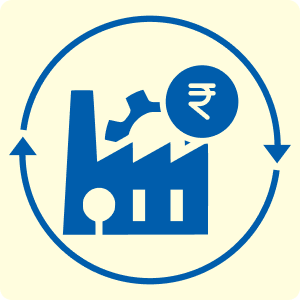Rs. 40000 - Rs. 55 lakh
You may be eligible for a pre-approved offer
Enter mobile and OTP | Check offer | No branch visit needed
Bajaj Finance
Organisations across the globe rely heavily on funds and credit to operate efficiently. Similarly, individuals often require financial support for personal or business purposes. To make informed choices, it is important to understand the difference between loans and advances, explore the various types of loans available, and learn how short-term loans and advances can address urgent requirements.
Since instant access to large sums of money is uncommon, borrowing becomes a practical solution. Both loans and advances serve distinct purposes in the financial ecosystem, and knowing their differences helps you choose the right financing option for your specific needs.
You can easily apply online for a Bajaj Finserv Personal Loan and enjoy instant approval and quick disbursal:
✅ Check your pre-approved loan offer with phone number and OTP → Apply online in 5 minutes → Receive funds within a day*.
What is a loan?
A loan is a form of debt financing in which one party (the lender, who is generally a financial institution or a bank) lends money to another party (the borrower), who is then obligated to pay back the loan plus interest. The borrower may or may not be required to put up collateral when applying for a loan, depending on whether the loan is secured or unsecured.
The interest rate, fees, and repayment tenure of the loan can vary from one lender to the next and even from loan to loan. A loan can be used to pay for everything from a car to home renovation expenses to higher education to running a business.
What is an advance?
Advance loans are short-term credit facilities offered to businesses to meet immediate operational needs. The loan advanced meaning refers to the disbursement of funds before a service is completed or revenue is generated, helping maintain liquidity. Terms are usually set by the lender and the central bank.
Types of advances
It is important to know the different types of advances to choose the right fit for you. The various kinds of advances include:
- Short-term loan: The full amount is disbursed to the borrower at once in this type of loan. The loan tenure of payback is typically shorter, and hence this loan type is used by businesses to cover their operating expenses.
- Overdraft: An overdraft is a bank service that lets a customer take out more money than they have in the account, up to a certain limit.
- Bill purchase: Loans given by the bank in exchange for securing the bills/ invoices to be paid to you are known as bills purchase.
- Cash credit: This is a feature offered by the bank that allows customers advance funds up to the value of a pledged asset.
What are the different types of loans and advances?
Different types of loans include secured and unsecured loans such as personal loans, mortgages, auto loans, student loans, and business loans. Personal loans cater to individual needs, student loans cover education costs, and business loans support entrepreneurial ventures. Each type serves specific financial requirements.
Secured loans
Secured loans are loans backed by collateral, such as property or assets. If the borrower fails to repay, the lender has the right to seize the collateral to recover the loan amount. These loans typically offer lower interest rates because they are less risky for the lender. Examples include home loans and car loans.
Unsecured loans
Unsecured loans do not require any collateral, making them riskier for lenders. As a result, they often come with higher interest rates. Lenders rely on the borrower's creditworthiness and financial history to assess the risk. Personal loans and credit cards are common examples of unsecured loans.
Pro tip: It is important for the person taking out a loan or an advance to know how each one works and what the main pros and cons are. Therefore, you should be very selective in the organisation you choose to collaborate with on this venture.
Key differences between loans and advances
Both individuals and businesses widely use loans and advances as financial tools to secure funds. While both provide access to money, they serve different purposes and follow different terms. To make informed financial decisions, it is important to understand the difference between loans and advances. Below are the major points that clearly distinguish loans from advances:
- Loan Amount:
- When a corporation or an individual makes a loan application, it is usually for a considerable sum of money. This can be used to set up commercial operations, buy inventory, or put money into research & development. When people take out loans, for example, a personal loan, they usually use the money for expensive things like renovating their home, paying for higher education, or planning a wedding.
- On the other hand, advances given to individuals or businesses are for much smaller amounts and are used to meet immediate or short-term financial goals.
- Repayment Duration
- Personal loans, car loans, education loans, and home loans all have longer repayment terms. A personal loan may have a maximum term of 8 years, whereas a home loan could have a maximum term of 30 years. Equated monthly instalments (EMIs) are the preferred method of repayment during the loan's specified tenure.
- Advances have much shorter periods for paying them back, usually between 3 months and a year at most. The agreement between the lender and the borrower will determine the terms of repayment.
- Interest Rates
- Financial institutions charge interest on loans, which is added to the principal when the loan is paid back. The interest component is proportionately spread across the repayment tenure and is calculated based on the principal amount borrowed. The purpose of the fee is to cover the risk of approving the funds and the value of money over time.
- Advances, on the other hand, are usually paid back in less than a year, and the interest is usually not very high. Hence, both the risk and the financial worth are substantially lower.
- Collateral Requirements
- Financial institutions may request a collateral deposit at the time of loan acceptance if the amount of the loan is substantial. This serves as a form of security that can be taken by the bank or NBFC if the borrower fails to make loan repayments for a specified period of time. Land, property, gold, fixed deposits, certain types of shares, and other items can be used as collateral.
- When it comes to advances, you usually do not have to put up anything as security. Lenders may sometimes ask for a fixed deposit or a guarantee as the main security.
- Usage Flexibility
- Loans are typically sanctioned for specific purposes, such as buying a home, financing a vehicle, or funding education. The borrower must use the funds as stipulated in the loan agreement. Advances, on the other hand, offer greater flexibility and are often extended for short-term needs, such as working capital for businesses or immediate financial requirements.
- Documentation and Approval
- Loans involve extensive documentation and a thorough approval process. Borrowers need to submit proof of income, identity, and collateral (if applicable). Advances usually require less paperwork and have a faster approval process, as they are designed to address urgent financial needs.
- Borrower Eligibility
- Eligibility for loans depends on various factors such as credit score, income level, employment status, and the borrower's repayment capacity. Advances, however, are typically granted based on the borrower's existing relationship with the lender, such as an active bank account or ongoing business transactions.
- Purpose
- Loans are structured for long-term financial goals, such as property purchase, higher education, or large-scale business expansion. Advances are meant for short-term needs, such as meeting day-to-day operational expenses or bridging temporary financial gaps.
- Processing Time
- Loan processing usually takes longer due to detailed credit assessments and documentation requirements. It can range from a few days to weeks. Advances are processed much faster, often within 24-48 hours, given their short-term and urgent nature.
- Risk
- Loans carry a lower risk for the lender, especially when backed by collateral, but they involve higher stakes for the borrower due to the larger amounts and longer tenures. Advances are riskier for lenders as they are often unsecured and rely heavily on the borrower's credibility and repayment history.
- Legal Formalities
- Loans require comprehensive legal agreements that clearly define terms, conditions, and penalties. Advances involve minimal legal formalities, often relying on simpler agreements or promissory notes, given their short-term nature and smaller amounts.
- Nature of Transaction
- Loans are formal and structured financial products with predefined terms for repayment, interest rates, and tenure. Advances are more informal and flexible, usually offered as an overdraft or credit facility that can be adjusted based on the borrower's immediate requirements.
Loans vs advances comparison table
| Basis of Comparison | Loans | Advances |
|---|---|---|
| Purpose | Long-term financial needs | Short-term operational or working capital needs |
| Tenure | Usually long-term | Usually short-term |
| Repayment | Monthly instalments over time | Repaid within a year or as per agreement |
| Security | Often requires collateral | May or may not require security |
| Interest Rate | Generally fixed or floating | Usually lower than long-term loans |
Similarities between loans and advances
While loans and advances serve different purposes, they share several similarities that make them essential financial tools:
- Financial support: Both provide necessary funds to meet personal or business financial requirements.
- Repayment obligation: Borrowers must repay the borrowed amount, often with interest, within an agreed timeframe.
- Documentation: Both transactions involve some level of documentation, though the extent varies.
- Creditworthiness assessment: Lenders evaluate the borrower's creditworthiness before disbursing funds.
- Interest charges: Both loans and advances accrue interest, which is a primary source of revenue for the lender.
In essence, loans and advances function as key instruments to bridge financial gaps, enabling individuals and businesses to meet their objectives efficiently.
Loan vs advance - Which one is better?
The choice between a loan and an advance depends on your financial needs, urgency, and repayment capacity. Here's a comparison to help you decide:
- Purpose: Loans are better for long-term needs like buying a house, starting a business, or financing education. Advances are ideal for short-term, specific needs like salary advances or working capital.
- Amount: Loans usually offer larger amounts, whilst advances provide smaller sums for immediate requirements.
- Repayment period: Loans come with longer repayment terms and structured EMIs. Advances are typically repaid in a shorter timeframe, often within months.
- Flexibility: Loans allow greater flexibility in usage, whereas advances are often tied to specific purposes.
- Processing time: Advances are quicker to process compared to loans, which require detailed documentation and approval.
- Approval ease: Advances are easier to obtain if you have an existing relationship with the lender, whilst loans require extensive evaluation.
Evaluate your financial goals and repayment ability to choose the most suitable option.
Conclusion
Recognising the loan and advance difference is key to making smart financial decisions. Loans are typically designed for long-term goals, whereas a fast loan advance can help manage urgent or short-term needs. Always choose the option that best matches your financial situation, repayment ability, and urgency for a smooth borrowing experience.
Bajaj Finserv Personal Loan could be the best option for all your personal loan needs. You can get a high value loan with a flexible repayment period. With the help of a personal loan EMI calculator, you can also figure out how much your monthly payments will be. This will help you make a good plan for your money and let you pay back the loan on time.
Key offerings: 3 loan types
Personal loan interest rate and applicable charges
Type of fee |
Applicable charges |
Rate of interest per annum |
10% to 31% p.a. |
Processing fees |
Up to 3.93% of the loan amount (inclusive of applicable taxes). |
Flexi Facility Charge |
Term Loan – Not applicable Flexi Loans –Up To Rs 1,999 To Up To Rs 18,999/- (Inclusive Of Applicable Taxes) |
Bounce charges |
Rs. 700 to Rs. 1,200/- per bounce “Bounce Charges” shall mean charges levied on each instance in the event of: (i) dishonour of any payment instrument irrespective of whether the customer subsequently makes the payment through an alternate mode or channel on the same day; and/or (ii) non-payment of instalment(s) on their respective due dates where any payment instrument is not registered/furnished; and/or (iii) rejection or failure of mandate registration by the customer’s bank. |
Part-prepayment charges |
Full Pre-payment: |
Penal charge |
Delay in payment of instalment(s) shall attract Penal Charge at the rate of up to 36% per annum per instalment from the respective due date until the date of receipt of the full instalment(s) amount. |
Stamp duty (as per respective state) |
Payable as per state laws and deducted upfront from loan amount. |
Annual maintenance charges |
Term Loan: Not applicable Flexi Term (Dropline) Loan: Up to 0.30% (Inclusive of applicable taxes) of the Dropline limit (as per the repayment schedule) on the date of levy of such charges.
Up to 0.30% (Inclusive Of Applicable Taxes) Of The Dropline Limit During Initial Tenure. Up to 0.30% (Inclusive Of Applicable Taxes) Of Dropline Limit During Subsequent Tenure |
Related articles
Disclaimer
Bajaj Finance Limited has the sole and absolute discretion, without assigning any reason to accept or reject any application. Terms and conditions apply*.
For customer support, call Personal Loan IVR: 7757 000 000









 Personal Loan
Personal Loan Check Eligibility
Check Eligibility Salaried Personal Loan
Salaried Personal Loan EMI Calculator
EMI Calculator Account Aggregator
Account Aggregator Credit Pulse Report
Credit Pulse Report
 Deals starting @99
Deals starting @99 Min. 50% off
Min. 50% off
 Bajaj Pay
Bajaj Pay Wallet to Bank
Wallet to Bank
 Easy EMI Loan
Easy EMI Loan Savings Offer
Savings Offer Smartphones
Smartphones Led TVs
Led TVs Washing Machines
Washing Machines Laptops
Laptops Refrigerators
Refrigerators Air Conditioner
Air Conditioner Air Coolers
Air Coolers
 Loan Against Shares
Loan Against Shares Loan Against Mutual Funds
Loan Against Mutual Funds Loan Against Insurance Policy
Loan Against Insurance Policy ESOP Financing
ESOP Financing Easy EMI Loan
Easy EMI Loan Two-wheeler Loan
Two-wheeler Loan Loan for Lawyer
Loan for Lawyer Industrial Equipment Finance
Industrial Equipment Finance Industrial Equipment Balance Transfer
Industrial Equipment Balance Transfer Industrial Equipment Refinance
Industrial Equipment Refinance Personal Loan Branch Locator
Personal Loan Branch Locator Used Tractor Loan
Used Tractor Loan Loan Against Tractor
Loan Against Tractor Tractor Loan Balance Transfer
Tractor Loan Balance Transfer Flexi
Flexi View All
View All
 Two-wheeler Loan
Two-wheeler Loan Bike
Bike Commuter Bike
Commuter Bike Sports Bike
Sports Bike Tourer Bike
Tourer Bike Cruiser Bike
Cruiser Bike Adventure Bike
Adventure Bike Scooter
Scooter Electric Vehicle
Electric Vehicle Best Sellers
Best Sellers Popular Brands
Popular Brands

 Trading Account
Trading Account Open Demat Account
Open Demat Account Margin Trading Financing
Margin Trading Financing Share Market
Share Market Invest in IPO
Invest in IPO All stocks
All stocks Top gainers
Top gainers Top losers
Top losers 52 week high
52 week high 52 week low
52 week low Loan against shares
Loan against shares
 Home Loan
Home Loan Transfer your existing Home loan
Transfer your existing Home loan Loan against Property
Loan against Property Home Loan for Salaried
Home Loan for Salaried Home loan for self employed
Home loan for self employed Loan Against Property Balance Transfer
Loan Against Property Balance Transfer Home Loan EMI Calculator
Home Loan EMI Calculator Home Loan eligibility calculator
Home Loan eligibility calculator Home Loan balance transfer
Home Loan balance transfer View All
View All
 Term Life Insurance
Term Life Insurance ULIP Plan
ULIP Plan Savings Plan
Savings Plan Family Insurance
Family Insurance Senior Citizen Health Insurance
Senior Citizen Health Insurance Critical Illness Insurance
Critical Illness Insurance Child Health Insurance
Child Health Insurance Pregnancy and Maternity Health Insurance
Pregnancy and Maternity Health Insurance Individual Health Insurance
Individual Health Insurance Low Income Health Insurance
Low Income Health Insurance Student Health Insurance
Student Health Insurance Group Health Insurance
Group Health Insurance Retirement Plans
Retirement Plans Child Plans
Child Plans Investment Plans
Investment Plans
 Business Loan
Business Loan Secured Business Loan
Secured Business Loan Loan against property
Loan against property Loans against property balance transfer
Loans against property balance transfer Loan against shares
Loan against shares Home Loan
Home Loan Loans against mutual funds
Loans against mutual funds Loan against bonds
Loan against bonds Loan against insurance policy
Loan against insurance policy
 Apply for Gold Loan
Apply for Gold Loan Transfer your Gold Loan with Us
Transfer your Gold Loan with Us Gold Loan Branch Locator
Gold Loan Branch Locator
 ULIP Plan
ULIP Plan Savings Plan
Savings Plan Retirement Plans
Retirement Plans Child Plans
Child Plans Free Demat Account
Free Demat Account Invest in Stocks
Invest in Stocks Invest in IPO
Invest in IPO Margin Trading Facility
Margin Trading Facility Fixed Deposit Branch Locator
Fixed Deposit Branch Locator
 Check your Credit Score
Check your Credit Score
 New Car Loan
New Car Loan Used Car Loan
Used Car Loan Loan Against Car
Loan Against Car Car Loan Balance Transfer and Top-up
Car Loan Balance Transfer and Top-up My Garage
My Garage
 Get Bajaj Prime
Get Bajaj Prime
 Mobiles on EMI
Mobiles on EMI Electronics on EMI Offer
Electronics on EMI Offer  Iphone on EMI
Iphone on EMI LED TV on EMI
LED TV on EMI Refrigerator on EMI
Refrigerator on EMI Laptop on EMI
Laptop on EMI Kitchen appliances on EMI
Kitchen appliances on EMI Washing machines
Washing machines
 Personal Loan EMI Calculator
Personal Loan EMI Calculator Personal Loan Eligibility Calculator
Personal Loan Eligibility Calculator Home Loan EMI Calculator
Home Loan EMI Calculator Home Loan Eligibility Calculator
Home Loan Eligibility Calculator Good & Service Tax (GST) Calculator
Good & Service Tax (GST) Calculator Flexi Day Wise Interest Calculator
Flexi Day Wise Interest Calculator Flexi Transaction Calculator
Flexi Transaction Calculator Secured Business Loan Eligibility Calculator
Secured Business Loan Eligibility Calculator Fixed Deposits Interest Calculator
Fixed Deposits Interest Calculator Two wheeler Loan EMI Calculator
Two wheeler Loan EMI Calculator New Car Loan EMI Calculator
New Car Loan EMI Calculator Used Car Loan EMI Calculator
Used Car Loan EMI Calculator All Calculator
All Calculator Used Tractor Loan EMI Calculator
Used Tractor Loan EMI Calculator
 Hot Deals
Hot Deals Clearance Sale
Clearance Sale Kitchen Appliances
Kitchen Appliances Tyres
Tyres Camera & Accessories
Camera & Accessories Mattresses
Mattresses Furniture
Furniture Watches
Watches Music & Audio
Music & Audio Cycles
Cycles Mixer & Grinder
Mixer & Grinder Luggage & Travel
Luggage & Travel Fitness Equipment
Fitness Equipment Fans
Fans
 Personal Loan for Doctors
Personal Loan for Doctors Business loan for Doctors
Business loan for Doctors Home Loan
Home Loan Secured Business Loan
Secured Business Loan Loan against property
Loan against property Secured Business Loan Balance Transfer
Secured Business Loan Balance Transfer Loan against share
Loan against share Gold Loan
Gold Loan Medical Equipment Finance
Medical Equipment Finance
 Smart Hub
Smart Hub ITR Service
ITR Service Digi Sarkar
Digi Sarkar
 Savings Offer
Savings Offer Easy EMI
Easy EMI Offer World
Offer World 1 EMI OFF
1 EMI OFF New Launches
New Launches Zero Down Payment
Zero Down Payment Clearance Sale
Clearance Sale Bajaj Mall Sale
Bajaj Mall Sale
 Mobiles under ₹20,000
Mobiles under ₹20,000 Mobiles under ₹25,000
Mobiles under ₹25,000 Mobiles under ₹30,000
Mobiles under ₹30,000 Mobiles under ₹35,000
Mobiles under ₹35,000 Mobiles under ₹40,000
Mobiles under ₹40,000 Mobiles under ₹50,000
Mobiles under ₹50,000
 Articles
Articles
 Overdue Payments
Overdue Payments Other Payments
Other Payments
 Document Center
Document Center Bank details & Documents
Bank details & Documents Tax Invoice Certificate
Tax Invoice Certificate
 Do Not Call Service
Do Not Call Service
 Hamara Mall Orders
Hamara Mall Orders

 Fixed Deposit (IFA) Partner
Fixed Deposit (IFA) Partner Loan (DSA) Partner
Loan (DSA) Partner Debt Management Partner
Debt Management Partner EMI Network Partner
EMI Network Partner Became a Merchant
Became a Merchant Partner Sign-in
Partner Sign-in
 Trade directly with your Demat A/c
Trade directly with your Demat A/c ITR
ITR My Garage
My Garage
 Live Videos - Beta
Live Videos - Beta
 Savings Offer
Savings Offer Smartphones
Smartphones LED TVs
LED TVs Washing Machines
Washing Machines Laptops
Laptops Refrigerators
Refrigerators Air Conditioners
Air Conditioners Air Coolers
Air Coolers Water Purifiers
Water Purifiers Tablets
Tablets Kitchen Appliances
Kitchen Appliances Mattresses
Mattresses Furniture
Furniture Music and Audio
Music and Audio Cameras & Accessories
Cameras & Accessories Cycle
Cycle Watches
Watches Tyres
Tyres Luggage & Travel
Luggage & Travel Fitness Equipment
Fitness Equipment Tractor
Tractor Easy EMI Loan
Easy EMI Loan
 vivo Mobiles
vivo Mobiles OPPO Mobiles
OPPO Mobiles Xiaomi Mobiles
Xiaomi Mobiles Sony LED TVs
Sony LED TVs Samsung LED TVs
Samsung LED TVs LG LED TVs
LG LED TVs Haier LED TVs
Haier LED TVs Godrej Refrigerators
Godrej Refrigerators Voltas Washing Machines
Voltas Washing Machines
 New Tractor Loan
New Tractor Loan Used Tractor Loan
Used Tractor Loan Loan Against Tractor
Loan Against Tractor Tractor Loan Balance Transfer
Tractor Loan Balance Transfer
 New Car Loan
New Car Loan New Cars Under ₹10 Lakh
New Cars Under ₹10 Lakh New Cars – ₹10–₹15 Lakh
New Cars – ₹10–₹15 Lakh New Cars – ₹15–₹20 Lakh
New Cars – ₹15–₹20 Lakh New Cars – ₹20–₹25 Lakh
New Cars – ₹20–₹25 Lakh New Car Brands
New Car Brands Petrol – New Cars
Petrol – New Cars Diesel – New Cars
Diesel – New Cars Electric – New Cars
Electric – New Cars CNG – New Cars
CNG – New Cars Hybrid – New Cars
Hybrid – New Cars










